How To Grow Your Email List 3x Faster Using Strategic Content
“The money is in the list.”
How many times have you heard this advice?
And it’s true – a large email list can be one of your greatest marketing assets when used correctly.
Here’s the problem:
Growing an email list is hard work. People are protective of their inboxes. They might click a link or follow you on social media, but they won’t give away their email addresses without significant persuasion.
This is why you need strategic content to grow your email list.
In this post, I’ll show you what strategic content is all about, why it works and how to create it.
Let’s dive in.
The methodology and examples you’ll find in this post are based on the publishing of B2B content. But with a few tweaks, you can apply the same process to B2C content.
What is strategic content?
It’s true:
The quality of a piece of content is a significant factor in how successful it will be.
But it’s not the only consideration.
It’s also important to consider the type of content and which platforms it will be shared on.
For example, if you’re promoting content on LinkedIn, list posts will get you more shares than an infographic:
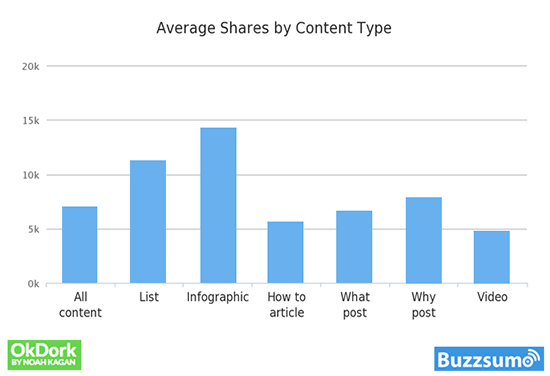
And when it comes to earning backlinks, list posts perform much better than infographics according to this study:
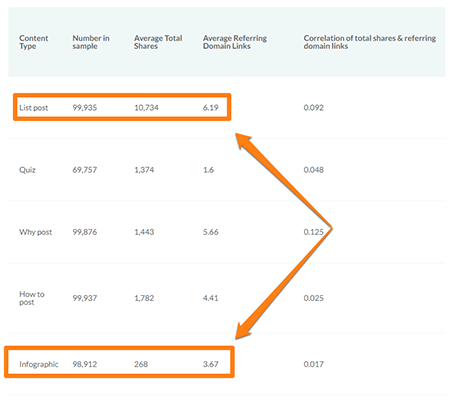
In the same way, some content topics and formats do better than others at capturing emails.
Figuring out your strategic goals, then creating content to meet that goal is called strategic content.
Strategic content requires that you work backwards from your goal. You don’t consider keywords or even the needs of your audience initially. Instead, you state your goal, then create content that is explicitly designed to meet your goal.
This is the complete 180 on how we usually craft content as bloggers. It flies in the face of all advice about keyword research and socially-relevant content formats. Instead, it focuses exclusively on meeting a strategic goal.
Just to clarify, I’m not saying you should ignore the needs of your audience. That’s important, but you need to figure out your strategic goals first to get clear on the needs of your audience. I’ll show you how to do this in the next section.
Strategic content usually has these characteristics:
- It is highly targeted, usually aimed at a narrow audience demographic.
- It is geared to meet a specific goal.
- It is promoted on platforms where the target audience already hangs out.
One great example of strategic content is case studies.
B2B businesses often produce case studies for different industries. These are neither keyword nor social-focused. Instead, their job is to show visitors that you have proven expertise and results in their industry.
The business might share a case study of its work with BMW to lure in automotive clients. For tech clients, it might share its results working with Microsoft.
And of course, this type of thing can work on a much smaller scale too.
While we’re focusing on building an email list in this post, you can apply the same methodology to any other types of goals. It’s also worth noting that your content strategy should include a mix of content created for different purposes.
How to create strategic content
The strategic content creation process can be broken down into two steps:
- Figuring out the strategic goals for your piece of content.
- Creating content that meets strategic goal requirements.
Let’s take a closer look at each of these steps below:
Figuring out strategic goals for your content
Your goal is to get more email subscribers.
But your strategic goal, however, defines who you want emails from and for what purpose.
So instead of saying “I want a larger email list,” you’d say something like:
I want more emails from self-funded startup founders in the social media niche to sell them my eBook on content promotion.
Let’s break down the key components of this example:
- Your target audience’s demographic and professional information.
- Your audience’s niche/industry.
- What you intend to do after they’ve subscribed to your email list (i.e., your end goal).
This will help you to identify:
- Content tone and style: What writing style and tone to use in your content. For example, senior executives in traditional industries prefer a more formal style than younger founders in emerging verticals (like social media).
- Content length and depth: You need to align the length/depth of the content with the audience’s needs. Busy CEOs at large companies can’t read 3,000-word articles. Beginner bloggers, on the other hand, would likely prefer something more detailed.
- Niche requirements: What technical terms, writing tone and content formats are common in your niche? If you’re writing for seasoned marketers you may not need to explain the difference between PPC and SEO, for example.
- Content promotion opportunities: What content promotion tools, platforms or channels can you promote your content on based on your audience demographics and niche? If you’re creating content for inbound marketers, for example, you can promote the content on Inbound.org. On the other hand, if you’re creating content for video gamers, you can promote the content on N4G.com.
- Content formats: What content formats are best suited to meet your end-goal? If you want to sell a service or get clients, for example, it’s better to create in-depth, expert focused content instead of creating an infographic.
Ideally, every piece of content you create should have a clear strategic goal. You can condense this goal in the form of a statement like the one I shared above.
But, how do you figure out your strategic goal?
Here’s how:
1. Work backwards from your end-goal
Start off by identifying which audience groups would help you accomplish that end-goal.
In the example above, I mentioned that my goal was to capture emails so I could sell an eBook on promoting a blog.
The market for people who would buy an eBook about promoting blog content is limited.
Most customers would be:
- Business owners (including startups) that already run blogs.
- Marketers who want to increase traffic to their clients’ blogs.
- Bloggers who want to get more traffic.
Each of these represents an audience group. Now let’s look at how to divide these groups further so we can get even more specific.
Now, you need to do the same thing based on your own end-goal.
2. Segment your audience groups
Part of the purpose of strategic content is to find and target highly specific audience groups.
“Bloggers who want more traffic” isn’t specific enough. “Travel bloggers with < 1 year of blogging experience” is.
For each of the audience groups you found in the previous step, ask yourself: “what specific sub-groups can I target?”
Look for:
- Sub-niches (e.g. Blogger -> Food blogger -> Street food blogger)
- Knowledge-level (beginner, intermediate, expert)
- Business stage (just founded, startup, established, etc.)
- Funding (self-funded, VC-funded)
- Revenue
So instead of “small business owners,” you might have “established businesses in the social media space with under $1M in revenue.”
In the next step, you’ll align each of these audience groups with customer personas.
Specificity will reduce the scope of your target audience. That might sound like a bad thing but it also makes it easier to cut through the noise and reach the right people. And because of that, you’ll be more likely to increase engagement and achieve your end-goal(s).
3. Create customer personas for each audience group
In the above step, you identified highly specific audience groups.
While useful, this doesn’t tell you who you should be writing content for. A senior marketer at an established business will want very different content from a CEO at the same business.
So, your next step should be to create a customer persona for each audience group.
As I mentioned in an earlier post on Blogging Wizard, a customer persona is:
…a snapshot of your ideal reader. Some refer to it as an avatar. A customer persona will include details about the challenges your ideal reader will face, what they value, where they hang out online and more.
You don’t have to include all of the above details here. At most, you should include your target audience’s:
- Age, so you can change your tone/style accordingly (older audiences would prefer a more serious tone than younger readers).
- Location, so you can add location-specific information in your content.
- Position, so you can address the specific concerns of the reader based on his position in the business.
And you’ll ideally want to target decision makers in each audience group:
- 1-20 employees: The decision maker is usually the founder(s).
- 21-100 employees: Decision makers are usually C-level executives (CMO, COO, etc.).
- 100+ employees: Senior managers and VP-level executives initiate and influence decisions.
There are a number of tools for finding the above information for creating buyer personas. LinkedIn search is a great option for this.
For example, if I’m targeting small digital marketing agencies, I can search for “digital marketing agency” on LinkedIn. Since I want small agencies, I can look up agencies with 11-50 employees.
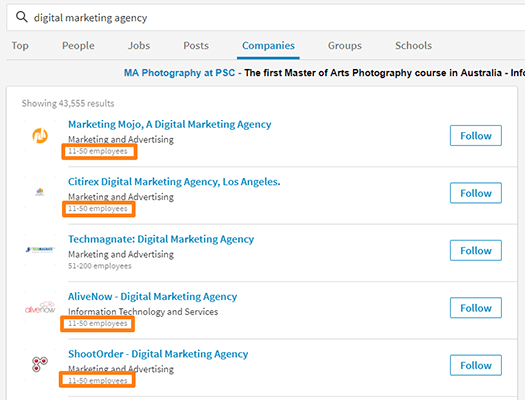
Dig through a few of these businesses. Make a note of their locations and then check out their employee listings on LinkedIn.
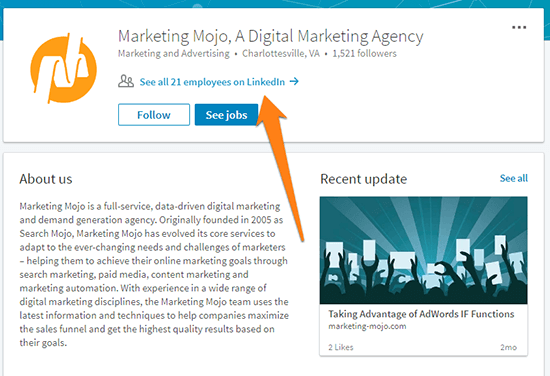
Look for decision makers (senior executives, CEOs, etc.). Take a guess at their age, education etc. You don’t have to be exact. Just a general age-range (like 35-50 years) would do.
Do this for 5-10 businesses for each group and you’ll have a decent idea of your target readers.
4. Create strategic goals with the above information
Take all of the data you’ve gathered so far and add it to a spreadsheet, like this:

In case it’s not too visible from the image, the headings are:
- Goal
- Niche
- Sub-niche
- Business size
- Business age
- Audience age
- Audience position
- Audience knowledge-level
Now, combine all of this data into a single statement using a template like this:
I want more email subscribers from [target audience position & industry] with [business size & age] who have [audience knowledge-level] to [end-goal].
For example, here’s a completed strategic goal statement:
I want more email subscribers from CMOs of social media marketing agencies with 11-50 employees who have advanced marketing knowledge to sell my eBook on how to promote your blog.
So, for a single end-goal you might have dozens of strategic goals, each with its own target audience.
I know this sounds like a tedious exercise but if you can do this, you’ll have highly targeted content that will speak to the specific concerns of each specific audience group.
This means your content will be far more likely to move the needle for your business.
Next, I’ll show you how to find the right content type to use for each strategic goal.
Create your strategic content
With the data you’ve gathered so far, you should already have a good idea of what kind of content to create for each strategic goal.
For example, if you’re targeting travel bloggers with intermediate-level knowledge, you’ll want to create an advanced guide.
Whereas if you’re targeting CMO’s at social media marketing agencies; case studies and thought leadership content would likely perform better.
Below, I’ll share some tips and tactics you can use to create strategic content.
Address key audience concerns
For strategic content to be successful, it has to address the concerns and needs of its target audience group.
For example, consider this article on ConversionXL:
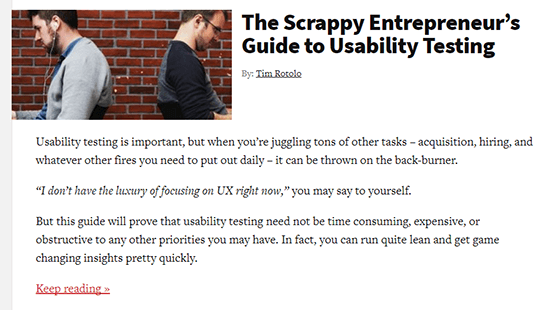
Instead of targeting “entrepreneurs” in general, it targets “scrappy entrepreneurs” – entrepreneurs with limited budgets and a DIY-spirit.
If you were a scrapper entrepreneur, your top concerns about usability testing would likely be:
- Whether usability testing is worth your time.
- Where to find testers.
- How to run tests.
- How to analyze test results.
- Free usability testing tools and resources.
Tim Rotolo addresses all these concerns in the ConversionXL article.
Take a close look at the audience profile for each of your strategic goals. For each audience group, ask yourself: what are my audience’s top concerns? What are their budgets, knowledge-level, and need for this content?
For example, consider this audience profile we created earlier:

As the CMO of an established startup, this reader likely has a decent budget, expert resources and at least a basic understanding of core marketing topics.
If you wanted to create content for this reader, you wouldn’t have a section on “what is content marketing?” – the reader would know this already.
And you wouldn’t focus on cheap or free solutions; as a busy CMO, this reader wants proven solutions, not some semi-useful free tool with lots of limitations.
Do this for all your audiences and you’ll have a clear idea of what kind of content to create for them.
You should mostly be looking at:
- Content depth: For advanced and intermediate-level audiences, don’t include basic knowledge. And when creating content for beginners, make sure to explain any and all jargon.
- Content focus: What kind of resources you include should match your audience. Don’t include “free” or “DIY” solutions when writing content for executives at established businesses; they want results, not just to save money. Similarly, when addressing beginners and bootstrapped businesses, don’t focus on expensive solutions.
The key here is to put yourself in the shoes of your audience and create something that addresses their specific requirements and concerns.
Use the right content type
One of the most important aspects of strategic content is how it aligns with your audience’s interests, needs and wants. Picking the right content type is key to doing this.
Here are two things to keep in mind when selecting your content type:
1. Align content format to buying stage
The buyer’s journey describes a hypothetical journey your customers take as they become aware of, interested in, and customers of your products.
This journey is broadly divided into three stages:
- Awareness: The stage where customers first become aware of your product, or of their own need for your product.
- Consideration: The stage where customers start considering your product as a solution to their problems.
- Decision: The stage where customers compare your product against others and make a purchase decision.
It’s well worth reading more about this important inbound marketing concept if it’s new to you.
For now, you should know that your choice of content format should align with your buyer’s journey stage.
For example, if your strategic goal is to target CMO’s in late decision stage, you’ll do better creating case studies and whitepapers.
Here’s Hubspot’s take on picking the best content format for each stage of the buyer’s journey:
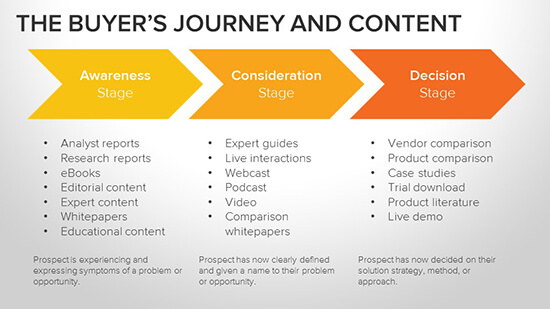
Use this as a guide when creating content to align with your strategic goals.
2. Create content that aligns with the reader’s demographics
Besides content format, you also need to align your content type, tone and style with your audience requirements.
Much of this is obvious – older audience groups would prefer a more formal tone. Busy executives would prefer punchier, shorter formats. Beginners would prefer in-depth guides, etc.
I covered this earlier, but to recap, here are two things to look for:
- Content style: Match the tone and style of the content to your audience’s age and position. Use a more conversational style for younger audiences. Use a more formal tone when writing for 50-year-old senior executives.
- Content length: Match the length of your content with the audience’s knowledge-level and time availability. Busy senior executives won’t read 5,000-word beginner-level posts. And beginners would get no value from 300-word ‘thought leadership’ content.
Doing this will make your content much more audience-friendly and in turn, increase conversion rates.
Marrying content type with list building tactic
The main focus of this post is to give you everything you need to know to get started with strategic content.
There are plenty of tactics you can use to grow your email database and get more leads. Which ones you deploy will depend on the types of content you select.
Ultimately, you need some sort of offer to encourage your audience to subscribe to your email list.
This is usually referred to as a lead magnet and it can take many forms. And be deployed via opt-in forms and/or targeted landing pages.
Note: If you use WordPress, you’ll find plenty of plugins you can use to add email capture forms, and build landing pages.
It could be a discount code, viral quiz results or a PDF featuring some sort of exclusive content. Possibly even a short educational course.
Or in some cases, the content type could be the lead magnet itself such as with gated whitepapers or trial downloads.
Here are some examples:
- Webcasts/Webinars: Your audience will give their email address to sign up for the webinar which would be managed by a webinar software platform such as Demio. The webinar tool will then add those email addresses to the email provider of your choice (e.g. ActiveCampaign/Drip).
- Whitepapers and reports: Readers will usually have to enter their email address in exchange for downloading the report/whitepaper via a landing page. Alternatively, you could make the content public and offer a PDF download in exchange for their email address. To further improve conversions, you could add some exclusive data only to the PDF version.
- Blog content: You could create a general lead magnet to offer on all of your blog posts via opt-in forms (slide-ins, popovers, in-content forms etc). Alternatively, you could increase conversions by offering post specific lead magnets known as content upgrades.
- Case studies: Similar to whitepapers and reports, you could offer case studies in exchange for an email address or publish them publically. Public case studies with plenty of actionable insights can perform especially well in terms of generating traffic and acquiring backlinks.
- Videos: Again, you can choose to make these available publically or as gated content in exchange for an email address. If you choose to publish these publically on your blog and/or YouTube, you’ll get better results when combining with a lead magnet/content upgrade of some description.
- Trial downloads: These are a popular form of gated content. Requiring an email address to download trials is an effective way to build a targeted email list.
- Live product demos: A potential customer will need to submit their contact details to book the product demo with one of your team.
Here’s the bottom line:
Let the content type decide which list building tactic to implement.
For some content types, the process of accessing the content will be the list building mechanism itself. Whereas other content will require additional content to encourage your audience to subscribe to your list. And that content, of course, can be repurposed.
Other content types will present you with several options. In that case, weigh up the pros and cons of each tactic.
Conclusion
Strategic content is the art and science of creating content that meets a strategic goal. And it has the potential to revolutionize your content marketing.
Instead of creating content for everyone, strategic content increases your conversion rates by helping you create targeted content for a narrow audience.
And because you’re addressing the audience’s specific needs in your content, you’ll benefit from improved conversion rates, and in turn, a larger email list. Email marketing gets a lot easier.
Use this guide as a starting point in understanding strategic content. Do some research to understand your audience thoroughly, then segregate them into narrow segments.
Once you understand each audience segment, create content that matches their needs and wants.
Do this and you’ll see a huge boost in your email subscription rates.
But you’re going to need the right tools to help you. So, if you’re new to email marketing, check out our roundup of the best email marketing services to get started.
